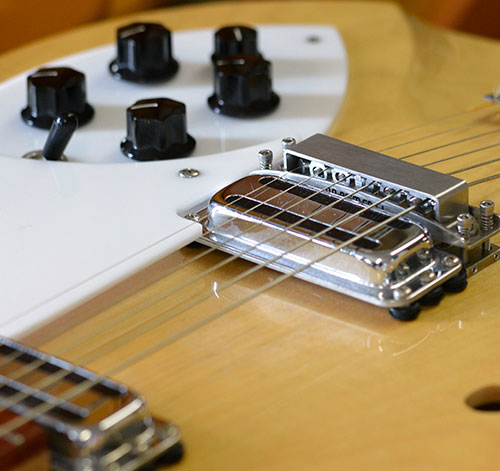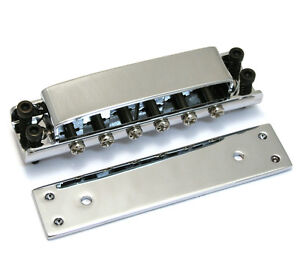You are using an out of date browser. It may not display this or other websites correctly.
You should upgrade or use an alternative browser.
You should upgrade or use an alternative browser.
Guitar talk: acoustic, bass, classical, twelve string? You name it! Pt II
- Thread starter matthewr
- Start date
- Status
- Not open for further replies.
Yank
Bulbous Also Tapered
On the subject of intonation..
I don't know if you guys remember but I had been looking at this interesting looking Linos guitar in the local classifieds. It's back on sale - after the buyer made a subtle but fairly important improvement:
https://www.adverts.ie/electric-guitars/linos-semi-solid-guitar/19651888
"Overall it's well built and solid and plays very well with a nice low action - the only issue I had when I got it is that the intonation was WAY off. It turns out that the neck scale length (25") meant that the bridge was located incorrectly, so I've plugged the original holes, repainted over them and located the bridge in the correct position."
I'd heard tales of some Chinese made guitars suffering from stuff like this, but thought it was just the usual guitar snobbery at play. No wonder that one has changed hands three time in the last 18 months - with a price drop each time
If you think it's bad that a Chinese guitar maker can't get their geometry right, wouldn't it be even worse if an American guitar manufacturer, in business since the 1930s and central in the creation of the electric guitar, also can't place a bridge in the right place?
Rickenbacker guitars have a bridge that is placed about 3/16" too close to the nut. Sometimes you can get the guitar to intonate with the saddles screwed all the way back, sometimes you need more.
Tony L
Administrator
Rickenbacker guitars have a bridge that is placed about 3/16" too close to the nut. Sometimes you can get the guitar to intonate with the saddles screwed all the way back, sometimes you need more.
I’ve never played, let alone worked on a real Rickenbacker guitar (I’ve played the basses), but that surprises me hugely. I’d heard the 12 string was a PITA to intonate, as 12 strings so often are, but there really is no excuse at all. I’ve never built a guitar in my life but I bet I could get the bridge in the right place with nothing more than a piece of string! Its just the distance from the nut to 12th fret again FFS! The Rick guitars are semis too aren’t they, i.e. a solid centre-block? So no way the bridge can move a bit the way they can on true hollow bodies (which usually have a floating bridge anyway), acoustics etc due to the top bowing/pulling up. Very odd/incomprehensible.
I know Dave from the ever wonderful ‘Dave’s World Of Fun Stuff’ hates them, worth searching out his Rickenbacker vids, they are very funny!
matthewr
spɹɐʍʞɔɐq spɹoɔǝɹ ɹnoʎ sʎɐld
Have you seen the Empress Effects Zoia pedal, Tony? Basically like a modular synth as a guitar pedal and kind of bonkers. Might also be a @stephen bennett sort of thing as well.
matthewr
spɹɐʍʞɔɐq spɹoɔǝɹ ɹnoʎ sʎɐld
Above videos are a basic intro and the sounds of some patches. More of a synth heads view in this one:
And loads more here : https://empresseffects.com/products/zoia
And loads more here : https://empresseffects.com/products/zoia
Stunsworth
pfm Member
Well, if we're talking synth pedals, this seems interesting...
gavreid
Pretty Words...
Fender done for price fixing in the UK...
https://www.theguardian.com/busines...maker-fender-fined-45m-for-price-fixing-in-uk
https://www.theguardian.com/busines...maker-fender-fined-45m-for-price-fixing-in-uk
Yank
Bulbous Also Tapered
I’ve never played, let alone worked on a real Rickenbacker guitar (I’ve played the basses), but that surprises me hugely. I’d heard the 12 string was a PITA to intonate, as 12 strings so often are, but there really is no excuse at all. I’ve never built a guitar in my life but I bet I could get the bridge in the right place with nothing more than a piece of string! Its just the distance from the nut to 12th fret again FFS! The Rick guitars are semis too aren’t they, i.e. a solid centre-block? So no way the bridge can move a bit the way they can on true hollow bodies (which usually have a floating bridge anyway), acoustics etc due to the top bowing/pulling up. Very odd/incomprehensible.
I know Dave from the ever wonderful ‘Dave’s World Of Fun Stuff’ hates them, worth searching out his Rickenbacker vids, they are very funny!
The Ric bridge is supported by four screws which contact a plate that is screwed to the top of the guitar.


There are four divots in the plate to locate the screws. The bridge is held down by string pressure, but the plate is screwed in place. If they had just elongated the two screw holes into slots, this could be corrected more easily.
Tony L
Administrator
This is rather interesting. A shame they did the test through a distorted Marshall, but the trend history was all new to me (heavy gauge being a recent fashion) and I tend to agree with their sonic conclusion (though I just don’t like the Marshall sound). FWIW I tend to use 10s on a Gibson scale length and 9s on a Fender, that way they kind of feel the same tension wise. My Yam is strung with 9s and sounds/feels great, though I’m now tempted to try 8s. I just wish they’d done the test clean though a Fender amp.
gavreid
Pretty Words...
This is rather interesting. A shame they did the test through a distorted Marshall, but the trend history was all new to me (heavy gauge being a recent fashion) and I tend to agree with their sonic conclusion (though I just don’t like the Marshall sound). FWIW I tend to use 10s on a Gibson scale length and 9s on a Fender, that way they kind of feel the same tension wise. My Yam is strung with 9s and sounds/feels great, though I’m now tempted to try 8s. I just wish they’d done the test clean though a Fender amp.
It's a good summary I think. Lighter strings emphasise the mids, which is what you want with a guitar- the old archtops in jazz bands used to do this naturally and with heavier strings (but those guys weren't bending notes
Tony L
Administrator
The other is that most modern guitars are built for 10s where the string tension balances the neck to give to correct amount relief. 9s (I've not tried 8s) can be too light sometimes and the neck remains too straight with the truss rod disengaged.
One of the reasons I’m curious about 8s is my 1978 Yamaha that has clearly spent its life locked in its case (it is pretty much mint condition) has ended up to my mind with a little too much relief. With 10s I needed the truss rod as tight as I’m personally prepared to torque it to get a standard 011 relief, with 9s I can get away with a little less, and I suspect if I went to 8s it may relax that bit further which would likely help long-term. As such I’m tempted to string it with 8s just as a restorative ‘treatment’ for a few years just to let the neck settle back after so many years of what I assume is non-use. Tonally I could easily get away with it as the Yam is ‘fatter’ sounding than a Strat and I’ve already got some bass cut/treble boost dialled in on the amp. The only negative in doing this is my other most played guitar is my £50 1970 Yam classical and the lighter the strings on the electric get the greater the contrast between them becomes! I’m tempted to try it anyway.
The thing that surprised me was that 11s and up is a very recent thing starting with SRV, detuned heavy metal etc and that all the classic rock (Hendrix, Page etc) all played 8s or 9s. I’d be curious to know the history from a jazz/country perspective too, e.g. I’d always assumed the Nashville or surf ‘twang’ thing was from really heavy strings. Shame that wasn’t mentioned.
Yank
Bulbous Also Tapered
The thing that surprised me was that 11s and up is a very recent thing starting with SRV, detuned heavy metal etc and that all the classic rock (Hendrix, Page etc) all played 8s or 9s. I’d be curious to know the history from a jazz/country perspective too, e.g. I’d always assumed the Nashville or surf ‘twang’ thing was from really heavy strings. Shame that wasn’t mentioned.
In the '50s and '60s, when you bought a guitar it came from the factory strung with 12s. Maybe 13s on some acoustics or acoustic archtops. Light gauge string sets with 10s didn't appear on the market until almost the end of the 1960s. What many players did before then was to buy a set of guitar strings, plus a single plain banjo string. The banjo string goes on the high E, then put on the smallest five on the guitar and throw away the big .054 or .056. Some guys would buy two banjo strings and move the guitar set over two places, to get an ultra-light set.
So through the 1970s the trend was for lighter and lighter sets, with .008 or even .007 for the high E. In the 1980s things kinds swung back with SRV and others promoting heavier strings, but that was always a minority of real players. I think most real players settled on .010 as a "normal" set before the end of the 1970s.
Tony L
Administrator
Just watched the Brett Shull video. I’ve no idea who he is, but his choice of sounds are much more to my taste so it was useful. I’m agreeing with both that thinner is better, it was especially obvious in the fuzz tone (‘Timmy’ pedal) and to my surprise I think I preferred the clean sounds too. I’m already perfectly happy with 9s on the Yam, so the question is whether to try going down to 8s or not? I think I’ll give it a go...
Given these two videos largely debunk the ‘heavy = good tone’ argument I can see no reason for staying with 10s or above as its just more playing effort and will munch through the guitar’s frets far faster.
Given these two videos largely debunk the ‘heavy = good tone’ argument I can see no reason for staying with 10s or above as its just more playing effort and will munch through the guitar’s frets far faster.
gavreid
Pretty Words...
Given these two videos largely debunk the ‘heavy = good tone’ argument I can see no reason for staying with 10s or above as its just more playing effort and will munch through the guitar’s frets far faster.
I like the hybrid slinkys 9-46
- Status
- Not open for further replies.

